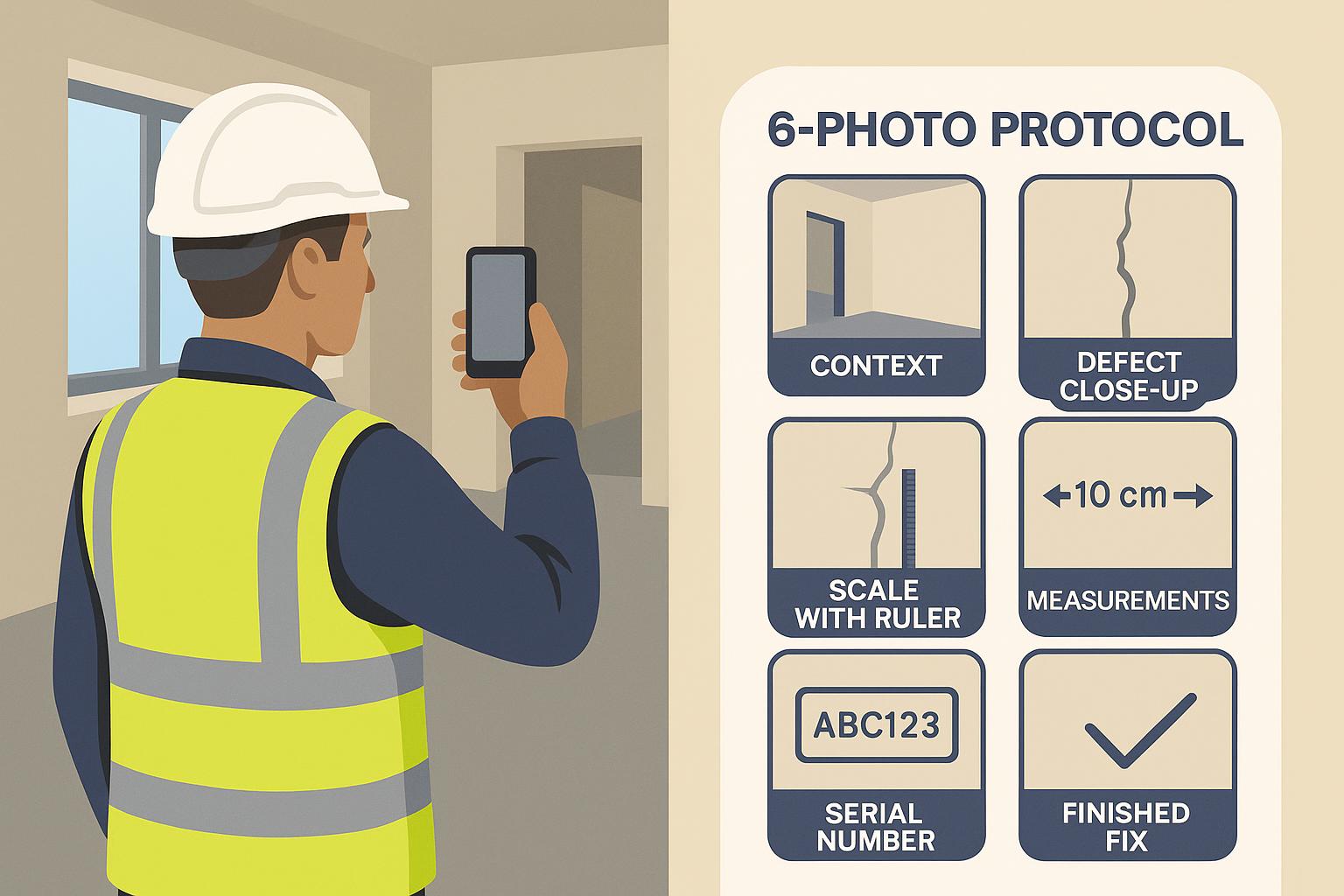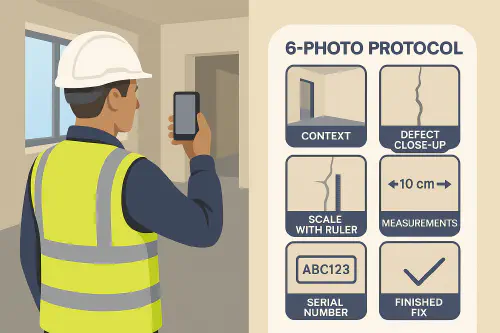
6 photo protocol for site evidence: what to photograph for snagging and disputes
6 photo protocol for site evidence: what to photograph for snagging and disputes
Category: Case Studies & Playbooks • Niche: site photos, snagging, evidence, offline apps, GDPR
Contents
- Quick answer
- Why this matters now
- The 6 photo protocol
- On-site workflow that takes under 3 minutes
- Tools that work offline
- Naming, storage and retrieval
- GDPR and privacy on site
- FAQs
Quick answer
Use a simple 6 photo set for every item you install, repair or snag:
- Context wide shot
- Defect or detail close-up
- Scale shot with ruler or known object
- Measurement or test result (level, pressure, continuity, airflow)
- Serial or batch number (where relevant)
- Finished fix or final state
This standard makes photos easy to understand by clients, site managers and insurers. It also speeds up approvals and reduces disputes.

Engineer taking standardised 6 photo protocol on a new build site
Why this matters now
- First time fix and fewer returns. Clear evidence helps supervisors sign off without reattending.
- Faster payments. Your invoice and report are backed by photos, so approvals move quicker.
- Compliance. For building control or Part L, a photo pack is already standard. See our Part L photo evidence workflow.
- Dispute protection. When something is questioned weeks later, you can prove what was done, when and where.
The 6 photo protocol
1) Context wide shot
Stand back. Capture the room or elevation so anyone can find the location later. Include a simple label or your sticker in frame.
2) Defect or detail close-up
Fill the frame with the issue or detail. Use raking light from a torch to show surface defects.
3) Scale shot
Place a ruler, a level, or a credit card next to the item. For gaps, a feeler gauge or card shows scale clearly.
4) Measurement or test
Photograph the meter or gauge: spirit level bubble, boiler pressure, multimeter reading, airflow tissue test on fans, RCD trip test screen, moisture meter, temperature probe.
5) Serial or batch number
Capture serials on boilers, appliances, extract fans, fire detectors, valves, fittings or materials where batch traceability matters.
6) Finished fix
After the repair or install, take the final shot showing neatness, sealant continuity, correct fall, covers back on, and area clean.
On-site workflow that takes under 3 minutes
- Open the job record. Add a single line item per snag, install or repair.
- Shoot the 6 photos in order. On iPhone/Android, burst is fine; rename later.
- Add one line of text: what, where, result. Example: “Bath 1, hot on left, no leaks after 2 minute run, extract fan holds tissue.”
- If there is a measurement, type the value too for search.
- Tag the item severity and owner (joiner, plumber, electrician).
- Submit when you have signal, or let it sync later.
Tip: For quick site reporting from your phone, see Construction photo report from your phone and Build an AI site diary from photos and voice notes.
Tools that work offline
You do not need full site Wi‑Fi to use this. Most job apps can capture offline and sync later.
- Fieldwire. Supports offline forms and photo capture. Read: Can I use Fieldwire while offline? and Introduction to the Photos tab.
- GoCanvas. Caches forms and reference data for offline use; syncs when back online. Design forms with required photos for any fail.
- Fulcrum, Forms On Fire, Device Magic. All support offline data capture, GPS and photos with later sync.
If you already use ServiceM8, Jobber or Tradify, you can still apply the 6 photo protocol inside their job notes or forms.
A short external overview video: Guidelines for capturing on-site progress
https://www.youtube.com/watch?v=LtDB-Rf-_l0
Naming, storage and retrieval
A simple scheme saves hours later.
- Folders: Site > Plot or Unit > Room or Area > Date
- Filenames: Site_Plot_Room_Item_Stage_Date Example: WillowPk_P23_Bed1_Rad_3-Scale_2025-09-27.jpg
- Keep originals with EXIF timestamps. Only crop or adjust exposure lightly.
- Keep a register per job: ref, location, description, severity, photo IDs, owner, target date, status.
Project
└── Willow Park
└── Plot 23
├── 2025-09-27
│ ├── 01_Bath1_1-Context.jpg
│ ├── 01_Bath1_2-Close.jpg
│ ├── 01_Bath1_3-Scale.jpg
│ ├── 01_Bath1_4-Test.jpg
│ ├── 01_Bath1_5-Serial.jpg
│ └── 01_Bath1_6-Finished.jpg
└── registers
└── snag-register.xlsx
Also see our Snagging list template with closeout flow.
GDPR and privacy on site
This is general guidance, not legal advice. If people are identifiable in images, that is personal data. Be transparent and minimise capture.
- Put up clear site notices stating that photography is used for safety, quality and records.
- Choose a lawful basis. For routine site records, legitimate interests is common. Avoid relying on worker consent for routine records. See the ICO’s CCTV and video surveillance guidance: Overview page.
- Minimise. Avoid welfare areas, neighbours’ homes and the public where possible. Do not record audio unless necessary and assessed.
- Retention. Set and document retention periods. Restrict access. Be able to find and redact other people if someone requests their images.
Useful ICO pages:
FAQs
What is the 6 photo protocol?
A simple standard set of photos per item: context, close‑up, scale, measurement, serial, and finished fix. It makes your evidence fast to review.
Do I need consent to take site photos?
For routine site records, employers usually rely on legitimate interests rather than consent, but you must be transparent and minimise capture. See the ICO guidance.
Will this help with payments and disputes?
Yes. A clear 6 photo set plus brief notes is often enough to approve variations, prove first time fix, or defend workmanship.
Which apps work if there is no signal?
Fieldwire, GoCanvas, Fulcrum and Forms On Fire all support offline photos and forms with later sync. Most job management apps can capture notes and photos offline too.
How should I name files?
Use Site_Plot_Room_Item_Stage_Date and keep a simple folder structure per plot or unit. Keep originals with timestamps.
{
"@context": "https://schema.org",
"@type": "FAQPage",
"mainEntity": [
{
"@type": "Question",
"name": "What is the 6 photo protocol?",
"acceptedAnswer": {"@type": "Answer", "text": "A standard set of six photos per item: context, close-up, scale, measurement, serial, and finished fix."}
},
{
"@type": "Question",
"name": "Do I need consent to take site photos?",
"acceptedAnswer": {"@type": "Answer", "text": "For routine site records, employers commonly rely on legitimate interests with clear notices and data minimisation. See ICO guidance."}
},
{
"@type": "Question",
"name": "Which apps work if there is no signal?",
"acceptedAnswer": {"@type": "Answer", "text": "Fieldwire, GoCanvas, Fulcrum and Forms On Fire support offline capture with later sync. Many job apps also work offline for photos and notes."}
},
{
"@type": "Question",
"name": "How should I name files?",
"acceptedAnswer": {"@type": "Answer", "text": "Use a simple convention like Site_Plot_Room_Item_Stage_Date and keep a per‑plot folder. Keep original EXIF timestamps."}
},
{
"@type": "Question",
"name": "Will this help with payments and disputes?",
"acceptedAnswer": {"@type": "Answer", "text": "Yes. Standardised evidence speeds approvals and helps defend workmanship in case of disputes."}
}
]
}
Want to slash training times and increase revenue per Engineer? Join our Waitlist: https://trainar.ai/waitlist